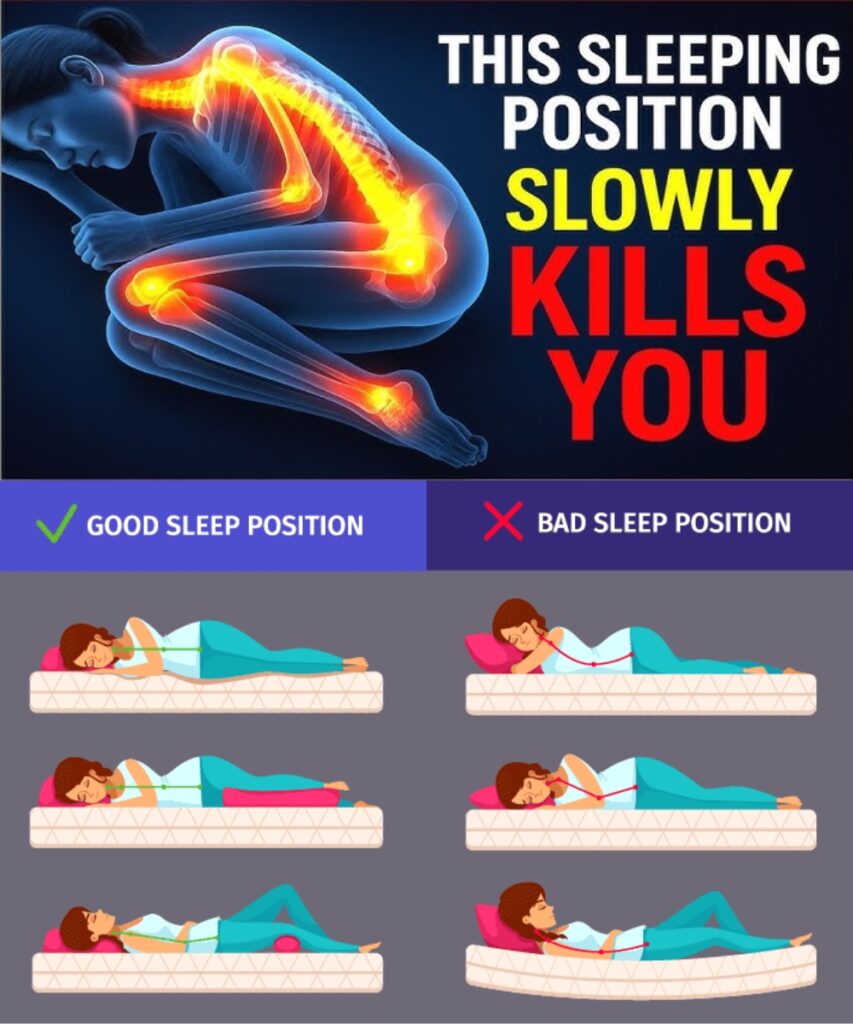The Most Dangerous Sleeping Position: What You Didn’t Know Could Be Harming Your Health
We all know sleep is essential. It’s when your body resets, repairs, and restores. But here’s something you might not have considered: your sleeping position could be slowly damaging your health—night after night, without you realizing it.
Let’s uncover the worst sleeping position, the science behind its risks, and smarter ways to rest your body and mind.
🛑 The Sleeping Position Experts Warn Against: Lying on Your Back
Shocked? You’re not alone. Sleeping on your back is often recommended for posture—but it’s far from ideal for many people. In fact, for certain conditions, it’s downright harmful.
🚨 Why Back Sleeping Can Be a Silent Health Threat:
1. Increases Risk of Sleep Apnea
When lying flat on your back, your tongue and soft palate can collapse backward, partially blocking the airway. This often leads to snoring, interrupted breathing, and even dangerous drops in oxygen levels—especially for those with undiagnosed obstructive sleep apnea.
2. Spinal Misalignment and Back Pain
Sleeping without proper lumbar support can flatten the natural curve of your lower back, placing stress on the spine, neck, and shoulders. You may wake up feeling sore, stiff, or with tension headaches that last throughout the day.
3. Triggers Acid Reflux and GERD
If you suffer from heartburn, lying on your back can worsen symptoms by making it easier for stomach acid to creep up into the esophagus.
😴 Other Common But Risky Sleep Positions
❌ Fetal Position – Too Curled Up
While it may feel cozy and safe, tucking yourself tightly into a ball can compress the diaphragm, restrict breathing, and increase pressure on joints.
❌ Always Sleeping on the Same Side
Side sleeping is generally beneficial, but always favoring one side can lead to muscle imbalances, hip misalignment, and shoulder pain over time.
❌ Spooning or Cuddling All Night
It’s romantic, sure—but spending the whole night in a spooning position can lead to awkward spinal curvature and pressure on the hips or lower back.
✅ The Best Sleep Positions for Your Health
🌙 Side Sleeping (with support)
This is often the safest, most ergonomic way to sleep. Use a medium-firm pillow to keep your head level with your spine. Switch sides occasionally to prevent stress on one shoulder or hip.
🌙 Loosely Curled Fetal Position
A gently bent fetal pose can help open the spine and reduce lower back tension—just avoid curling in too tight.
🌙 Pillow Between the Knees
This simple adjustment helps align your hips and spine, reducing pressure in the lower back and helping you wake up pain-free.
🛏️ Smart Sleep Habits to Improve Your Rest
-
Choose a Supportive Mattress
A medium-firm surface offers ideal spinal support—say goodbye to sagging foam or overly plush beds. -
Stick to a Sleep Schedule
Going to bed and waking up at the same time every day resets your circadian rhythm and promotes deeper sleep. -
Avoid Late Dinners
Finish your last meal at least 2–3 hours before bed to prevent nighttime acid reflux or discomfort. -
Slightly Elevate Your Head
For snorers or reflux sufferers, sleeping on a slight incline can dramatically reduce symptoms.
⚠️ Final Thoughts: Your Sleep Position Matters
It’s not just about how much sleep you get—but how you sleep.
The wrong position can cause poor breathing, digestive discomfort, chronic pain, and restless nights. But with a few mindful tweaks, you can transform your sleep from disruptive to deeply restorative.
So tonight, ask yourself:
-
Is your position helping or hurting your body?
-
Are your spine and airways supported?
-
Are you waking up energized or exhausted?
Make a small change. Sleep smarter. Wake stronger.
Sleep isn’t just rest—it’s your nightly investment in long-term health. 💡




